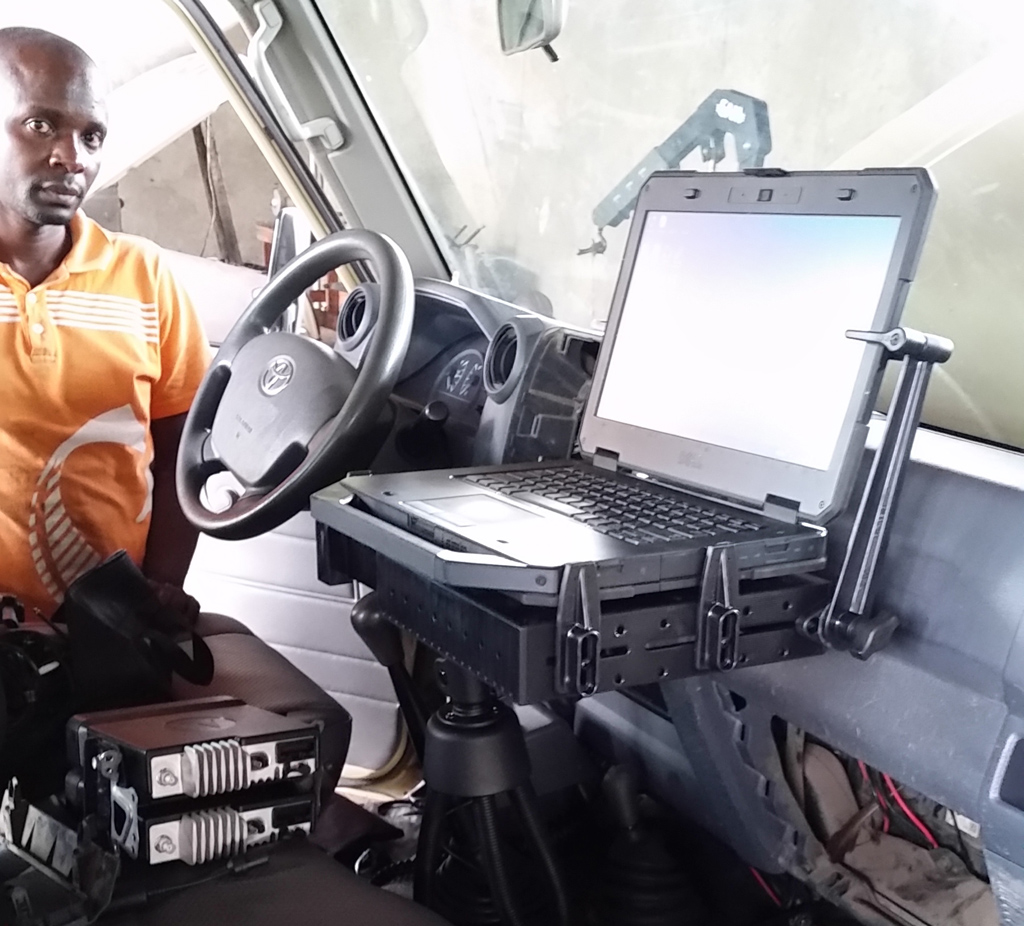The Virunga Communications Post Installation
Categories: Gorilla Journal, Journal no. 53, Protective Measures, Democratic Republic of the Congo, Virunga National Park, Mikeno, Mt. Tshiaberimu, Mountain Gorilla, Grauer's Gorilla
Security problems in the Virunga National Park, Democratic Republic of the Congo, have been a severe danger for the park's wildlife and its forests, and for the rangers who try to protect it. In order to improve the communication of the rangers, a new communication system was needed that covers the whole park and permits the park personnel to act quickly when problems are noticed anywhere.
A Mototrbo Digital VHF radio communications system was successfully commissioned for service for Virunga National Park on 06th July 2016 as part of Project Virunga VHF (Phase Two). The system was designed to replace an ageing Motorola VHF analog radio system in the Virunga National Park (VNP). Phase One of the project centred around the installation of a small Mototrbo digital VHF system specially for the rangers assigned to the protection of elephants within the central sector of the park.
The Mototrbo digital VHF radio with GPS tracking was selected as the communications system of choice for ensuring effective command and control of the entire VNP. The management of this system is the responsibility of the park’s technicians. It was selected for its increased capacity and spectrum efficiency, encryption, integrated data communications and enhanced voice capability. Across Africa it is fast becoming the defacto standard for wildlife protection organisations.
The budget was set at USD 350,000 and came at USD 345,650. Those managing the project were able to negotiate pricing and source direct from manufacturers where necessary and where appropriate. They were able to deliver system capabilities, procure unbudgeted spares and complete the equipment procurement earlier than expected and significantly below budget.
The Procurement Phase
This phase commenced on the 28 March 2016 following the signing of an agreement with the Virunga Foundation. The phase included 16 steps and a tight deadline of 8 weeks for delivery of 28 specific types of equipment, into Uganda. The timeframe had been stipulated by the Virunga Foundation.
The radio equipment was delivered 7 days earlier than the deadline, but unfortunately due to a rebel attack the Virunga Cessna 206 was out of service and al alternative aircraft had to be chartered resulting in equipment being delivered into Rumangabo on 06th June 2016.
The Deployment Phase
This phase commenced on the 04th June 2016, but delays in the locally procured solar system resulted in the deployment date being pushed back to 18th June 2016. The installation and training of Virunga radio engineers commenced immediately upon the consultant's arrival on 20th June 2016. Delays, to include misplaced equipment and differing opinions, had a negative impact on the amount of time available for training the engineers, but they did receive sufficient on-the-job training to enable them to manage and maintain the radio system. The system was commissioned for operation on the 4th July 2016.
Digital VHF Mototrbo Repeater Network: There are three repeaters located in positions around the park and an additional three repeaters for redundancy and use as back-up repeaters for future installations and network expansion as required. The coverage is very good, although there are still some 'black spots'.
TRBOnet Dispatch Console: The computer has been provided and will function as the operations centre for the VNP. The main operations room, known as CCOPS, has been temporarily moved from Rumangabo to Rwindi and as a result temporary installations had to be made. The TRBOnet Dispatch Console provides the operations room with an easy application that at a glance will enable the watch keeper to see which radios are active on the net and where they are. There are seven key features identified regarding the dispatch console. There are communications challenges between Rwindi and the southern sector repeater, and, as such, it has been recommended that VNP revert back to the original plan and have the CCOPS (GPS monitoring) and voice monitoring base station for the southern sector in Rumangabo in order to have effective command and control.
The mobile ops vehicle is a huge asset as radios have the capacity to have situational awareness of ranger positions within a single sector. The vehicle radio installation with GPS tracking have enabled effective fleet management and accountability of the vehicle drivers, and solutions have been put in place to ensure that the battery is always charged and the antenna is transmitting. It also addresses the issue of possible irregularities in fuel consumption and unauthorised vehicle usage.
The Smartphone Zello System has been implemented using custom-built technology to enable the radio voice network to be extended to other smartphone users running the Zello Push-to-Talk application. This system is suitable for use by covert users providing a closed system with radio access being controlled within the Virunga CCOPS/Security Office.
Ongoing Phase
Remote support is being delivered to two Virunga engineers who identified a couple of issues that either have now been or are in the process of being rectified. These include poor repeater battery power, wind turbine generator, and repeater constant transmit cycle.
Recommendations
In order to satisfy the requirements for the expansion of the parks communications system and in order to accommodate an increase in subscribers, we have made some additional recommendations for further enhancing the park’s communication capability, as well as providing ongoing training to include professional development specifically of the VNP technicians.
Robert Muir and Kevin Marriott

